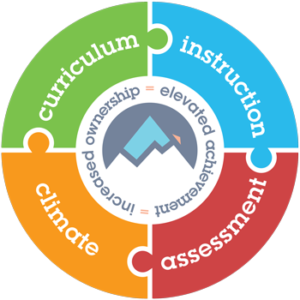Share this article.
Imagine walking into a classroom and finding students who were able to explain what they are learning, why they are learning it, and what ultimate success looks like. Imagine a school where kids loved learning and could explain their plan for achieving higher and higher year by year. Imagine talking with teachers who were able to articulate the schoolwide initiatives to increase student achievement and their specific role in them. Imagine walking into a meeting and seeing teachers working with their colleagues to clarify their understanding of the initiative and sharing their strengths and struggles. Imagine a school where teachers asked for help and support from the principal.
Can you imagine that this school is your school?
We can.
Educators know that motivation is the key to greater success. We, at Elevated Achievement, believe that motivation can be taught. We know that any principal can increase staff motivation, and thus achievement, by increasing ownership.
Using a variety of research about learning and, more specifically, adult learning, We provide school principals and other administrators with a set of strategic learning practices that form the foundation of the clear and consistent actions you can take to support your teachers’ ownership of their learning. Their ownership, in turn, will ensure successful implementation of school-wide initiatives focused on achievement. In other words, the strategic learning practices translate into the four actions of instructional leadership.
 How does a principal do this? First, principals model the thinking behind the ownership and explicitly address the skills of ownership. This takes planning. In order for all stakeholders to successfully support an initiative focused on increasing student achievement, principals must be strategic in the actions they use to support staff.
How does a principal do this? First, principals model the thinking behind the ownership and explicitly address the skills of ownership. This takes planning. In order for all stakeholders to successfully support an initiative focused on increasing student achievement, principals must be strategic in the actions they use to support staff.
While there are hundreds of actions a principal must take in a day, this article focuses on those practices and actions in curriculum, instruction, assessment, and climate that actually increase the opportunities for learning—and increase the opportunities for ownership. The strategic learning practices and actions of instructional leadership in each area are as follows.
Curriculum Support
All support and learning is driven by a clearly defined initiative with measurable and achievable outcomes.
The Practices That Drive Instructional Leadership
- Strategic Learning Practice, Curriculum 1: Each and every adult learner is supported by relevant expectations with measurable and achievable outcomes that are accessible and drive all learning.
- Strategic Learning Practice, Curriculum 2: Each and every adult learner is supported by a plan for learning that provides an integrated approach and that supports conceptual redundancy of the outcomes.
- Strategic Learning Practice, Curriculum 3: Each and every adult learner is supported by access to materials that match the content and rigor of the outcomes.
In other words . . .
- When teachers clearly understand the goal of the initiative, they have a better chance to be successful.
- When teachers clearly understand how the work of the initiative is integrated into their current work, they have a better chance to be successful.
- When teachers have access to appropriate and relevant resources, they have a better chance to be successful.
Which translates into . . .
The Actions of Instructional Leadership in Curriculum
- Clarify the goals of the initiative.
- Integrate the goals of the initiative with other expectations.
- Provide the resources needed to implement the initiative.
- Share this information with the staff.
Instruction Support
All support and learning is driven by highly engaging, effective, and efficient instruction.
The Practices That Drive Instructional Leadership
- Strategic Learning Practice, Instruction 1: Each and every adult learner is supported by opportunities for meaningful engagement using structured learner-to-learner communication.
- Strategic Learning Practice, Instruction 2: Each and every adult learner is supported by opportunities for meaningful engagement using highly effective instructional strategies.
- Strategic Learning Practice, Instruction 3: Each and every adult learner is supported by opportunities for meaningful engagement where instructional time is used efficiently.
In other words . . .
- When teachers have opportunities for meaningful engagement using structured learner-to-learner communication, they have a better chance to be successful.
- When teachers have opportunities for meaningful engagement using highly effective instructional strategies, they have a better chance to be successful.
- When teachers have opportunities for meaningful engagement where instructional time is used efficiently, they have a better chance to be successful.
Which translates into . . .
The Actions of Instructional Leadership in Instruction
- Clarify how the initiative will be supported and implemented.
- Establish a plan for professional learning opportunities.
- Schedule professional learning opportunities directly related to the initiative.
- Share this information with the staff.
Assessment Support
All support and learning is driven by regular assessment that guides decision-making.
The Practices That Drive Instructional Leadership
- Strategic Learning Practice, Assessment 1: Each and every adult learner is supported by data that is used to monitor current understanding and provide feedback.
- Strategic Learning Practice, Assessment 2: Each and every adult learner is supported by data that is used to monitor current understanding and adjust as needed.
- Strategic Learning Practice, Assessment 3: Each and every adult learner is supported by data that is used to differentiate based on predetermined needs.
In other words . . .
- When teachers clearly understand the data that is used to monitor current understanding and provide feedback, they have a better chance to be successful.
- When teachers clearly understand the data that is used to monitor current understanding and adjust as needed, they have a better chance to be successful.
- When teachers clearly understand the data that is used to differentiate based on their individual needs, they have a better chance to be successful.
Which translates into . . .
The Actions of Instructional Leadership in Assessment
- Confirm the success criteria for the initiative.
- Establish a method for monitoring the implementation of the initiative.
- Establish a method for continued support of implementation.
- Share this information with the staff.
Climate Support
All support and learning is driven by a positive professional climate.
The Practices That Drive Instructional Leadership
- Strategic Learning Practice, Climate 1: Each and every adult learner is supported by a respectful environment that recognizes and promotes professional behavior.
- Strategic Learning Practice, Climate 2: Each and every adult learner is supported by a cooperative environment that encourages risk-taking.
- Strategic Learning Practice, Climate 3: Each and every adult learner is supported by a collaborative environment that enhances individual productivity.
In other words . . .
- When teachers are supported by a respectful environment that recognizes and promotes professional behavior, they have a better chance to be successful.
- When teachers are supported by a cooperative environment that encourages risk-taking, they have a better chance to be successful.
- When teachers are supported by a collaborative environment that enhances individual productivity, they have a better chance to be successful.
Which translates into . . .
The Actions of Instructional Leadership in Climate
- Identify the role of each stakeholder in the implementation of the initiative.
- Foster cooperation among and between stakeholders.
- Establish a plan for collaboration.
- Share this information with the staff.
How Instructional Leadership Elevates Achievement
It is clear that the job of being a principal is hard work. You come to school each day motivated to provide your staff and your students with the highest quality support you can. But achievement can’t be elevated if only the principal is motivated. You must ensure that your staff is motivated to be active participants in the work. Taking ownership motivates everyone to elevate their achievement in all areas—and not just motivated for the individual needs of their classroom but motivated for the collective good of all students’ achievement. And, building this motivation is something you can control by increasing ownership.
 In order for you to implement a sustainable initiative, you must utilize the actions of instructional leadership to build a climate of ownership at your site. Research shows that you must honor the teachers by giving them the authority, capacity, and responsibility to implement the initiative. You do this by not only developing a plan that includes all facets of curriculum, instruction, assessment, and climate but also by differentiating how you delegate the work and how you communicate the work. These actions lead to professional motivation, which leads to more focused decision-making, which, in turn, leads to increased achievement for all students.
In order for you to implement a sustainable initiative, you must utilize the actions of instructional leadership to build a climate of ownership at your site. Research shows that you must honor the teachers by giving them the authority, capacity, and responsibility to implement the initiative. You do this by not only developing a plan that includes all facets of curriculum, instruction, assessment, and climate but also by differentiating how you delegate the work and how you communicate the work. These actions lead to professional motivation, which leads to more focused decision-making, which, in turn, leads to increased achievement for all students.
Let’s revisit that dream school. This is a clear example of a school where students, teachers, and administrators are all pulling together to increase learning. Each owns their role in the process. Each is supported by another—teachers support each and every student, administration supports each and every teacher, and they all support their colleagues.
Your dream school can be a reality because you control that reality.
Continue the Learning
Check out these articles and resources to continue your learning about this topic…
The Learning Brief
In this article you learned…
- That any principal can increase staff motivation, and thus achievement, by increasing ownership.
- The strategic learning practices and actions of instructional leadership in curriculum, instruction, assessment, and climate that actually increase the opportunities for learning—and increase the opportunities for ownership.
- How to utilize the actions of instructional leadership to build a climate of ownership at your site.
Can you imagine building an environment full of motivated, engaged, and eager students who own their learning?
We can.

